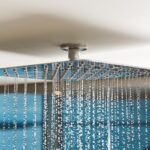Understanding bathroom faucet types
Bathroom faucets come in various styles and designs. They are essential fixtures in any bathroom renovation project. Standing washbasin faucets are popular choices for many homeowners. These faucets are mounted directly on the sink or countertop. Wall-mounted basin faucets offer a sleek, modern look. They save space and make cleaning easier. Shower faucets are crucial for a comfortable bathing experience. Each type serves a specific purpose in bathroom design.
The selection of bathroom faucets can significantly impact your bathroom’s functionality and aesthetics. Single-handle faucets are easy to use and maintain. Double-handle faucets offer more precise temperature control. Touchless faucets provide convenience and improved hygiene. Consider your household’s needs when choosing faucet types. The right faucet can enhance your daily routines and add value to your home.
Faucet finishes play a crucial role in bathroom decor. Chrome is a popular choice due to its durability and shine. Brushed nickel offers a softer, more matte appearance. Oil-rubbed bronze provides a rustic, antique look. Matte black finishes are gaining popularity in modern bathrooms. Choose a finish that complements your bathroom’s overall design theme.
Water efficiency is an important factor in faucet selection. Look for faucets with WaterSense labels. These models use at least 20% less water than standard faucets. Low-flow aerators can be added to existing faucets. They reduce water consumption without sacrificing performance. Consider faucets with flow rates of 1.5 gallons per minute or less. Water-efficient faucets can help lower your utility bills and conserve resources.
Installation requirements vary among faucet types. Standing washbasin faucets typically need one to three holes in the sink or countertop. Wall-mounted faucets require in-wall plumbing modifications. Ensure your chosen faucet is compatible with your existing plumbing setup. Some faucets may need additional mounting hardware or valves. Consult a professional plumber if you’re unsure about installation requirements.
Exploring wall-mounted basin faucets
Wall-mounted basin faucets offer several advantages in bathroom design. They create a clean, uncluttered look on the countertop. These faucets are ideal for smaller bathrooms where space is at a premium. Wall-mounted models come in various styles, from traditional to ultra-modern. They can be paired with vessel sinks or undermount basins for a customized look.
Installation of wall-mounted faucets requires careful planning. The rough-in valves must be installed before finishing the wall. Precise measurements are crucial to ensure proper placement. The spout should extend far enough over the sink to prevent splashing. Most wall-mounted faucets have a reach between 5 and 9 inches. Consider the sink depth when selecting the appropriate spout length.
Maintenance of wall-mounted faucets can be more complex than standard models. Access panels may be necessary for future repairs. These panels should be discreetly incorporated into the bathroom design. High-quality cartridges and seals can minimize the need for maintenance. Some manufacturers offer lifetime warranties on their wall-mounted faucets. This can provide peace of mind for homeowners considering this option.
Wall-mounted faucets can contribute to easier cleaning routines. With no base on the countertop, there are fewer areas for soap scum and grime to accumulate. The wall beneath the faucet remains dry, reducing the risk of water damage. This design also allows for more creative backsplash options. Homeowners can extend tile or other materials all the way up the wall behind the sink.
When selecting wall-mounted faucets, consider the overall bathroom theme. Sleek, minimalist designs work well in contemporary spaces. More ornate models can complement traditional decor. Pay attention to the handle design and spout shape. These elements can significantly impact the faucet’s visual appeal. Some wall-mounted faucets offer interchangeable handles for future style updates.
Selecting the perfect shower faucet
Shower faucets come in various configurations to suit different needs. Single-handle shower faucets are simple and space-efficient. Dual-handle models offer separate hot and cold water control. Thermostatic shower faucets maintain a consistent water temperature. This feature is particularly useful for households with children or elderly members. Consider the needs of all family members when choosing a shower faucet.
Water pressure is a crucial factor in shower faucet selection. Look for models with pressure-balancing valves. These prevent sudden temperature changes when water is used elsewhere in the house. High-pressure shower heads can provide a invigorating experience. Low-flow models can still offer satisfactory performance while conserving water. The average shower uses 2.1 gallons of water per minute. Water-efficient models can reduce this to 1.5 gallons or less.
Shower faucet finishes should coordinate with other bathroom fixtures. Chrome is a popular choice for its durability and easy maintenance. Brushed nickel and stainless steel resist water spots and fingerprints. Matte black finishes are trendy and can create a bold statement. Consider the longevity of the finish when making your selection. Some finishes may require special cleaning products to maintain their appearance.
Additional features can enhance the shower experience. Handheld shower heads offer flexibility for cleaning and personal care. Rain shower heads provide a luxurious, spa-like feel. Body sprays can be added for a custom shower system. Digital shower controls allow precise temperature and flow adjustments. These advanced features can significantly impact the overall cost of the shower faucet system.
Installation complexity varies among shower faucet types. Surface-mounted models are easier to install and replace. Concealed installations offer a cleaner look but require more extensive plumbing work. Consider future maintenance needs when choosing between these options. Some shower systems may require professional installation to ensure proper function and prevent leaks.
Maintaining your bathroom faucets
Regular maintenance can extend the life of your bathroom faucets. Clean faucets weekly with a mild soap solution. Avoid abrasive cleaners that can damage finishes. Dry faucets after cleaning to prevent water spots. Use a soft cloth to buff chrome and stainless steel finishes. This routine can keep your faucets looking new for years.
Check for leaks periodically to prevent water waste and damage. A dripping faucet can waste up to 3,000 gallons of water per year. Tighten loose connections and replace worn washers promptly. Cartridge-style faucets may need cartridge replacement every few years. Keep spare parts on hand for quick repairs. This proactive approach can save money on water bills and prevent costly repairs.
Hard water can cause mineral buildup on faucets. This can affect performance and appearance over time. Use vinegar or a commercial descaling solution to remove deposits. Soak aerators in vinegar overnight to clear blockages. Clean showerheads regularly to maintain proper water flow. Consider installing a water softener if hard water is a persistent issue in your area.
Protect your faucets from extreme temperature changes. Avoid using boiling water directly in sinks with attached faucets. This can damage internal components and affect water mixing. In cold climates, insulate pipes to prevent freezing. Open cabinet doors to allow warm air circulation around plumbing. These precautions can prevent costly damage to your faucets and plumbing system.
Keep tools and basic plumbing supplies on hand for minor repairs. A set of Allen wrenches, adjustable pliers, and a pipe wrench are essential. Plumber’s tape can help seal threaded connections. Silicone lubricant can keep moving parts functioning smoothly. Having these items readily available can save time and money on simple repairs. For complex issues, don’t hesitate to call a professional plumber.





